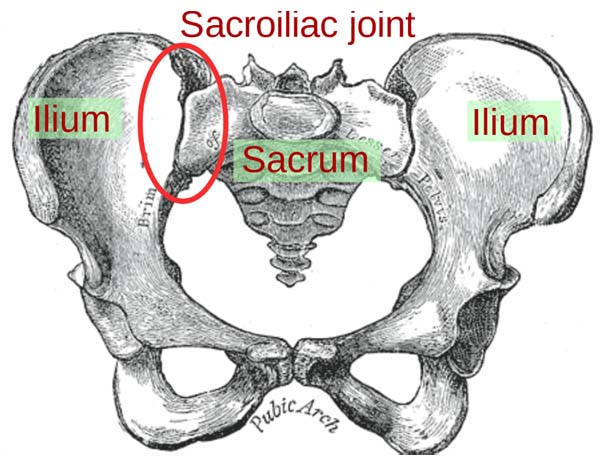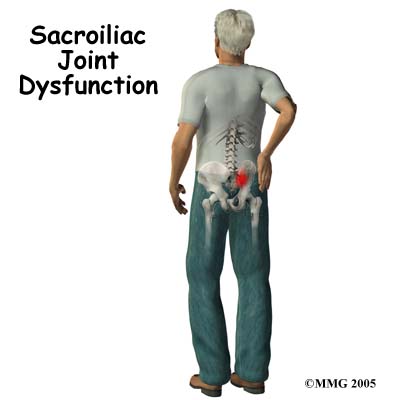Your underlying cause of pain may be stemming from dysfunction of your sacroiliac joint (SI Joint), which is the joint between your sacrum and ilium as circled in the image below. The pain occurs when the joint becomes either stiff or loose. For women, the joint is more prone to become loose during pregnancy and the menstrual cycle.

Sacroiliac (SI) Joint Pain Symptoms
Sacroiliac (SI) joint pain symptoms can be similar to low back pain, often radiating to the buttocks or back of the thigh. The type of pain may be sharp, stabbing or dull, and usually localized to one side of the pelvis/low back, groin or tailbone, with or without radiating symptoms. The image below shows the most common low back location of SI Joint pain.

Sacroiliac Joint Pain Causes
- Bending Forward, twisting low back
- Intercourse
- Prolonged sitting and standing
- Sneezing/Coughing
- Standing up from a sitting position
- Turning in Bed
- Walking/Running
- Weight bearing on the painful side (single leg activities)
- Different types of low back arthritis secondary to vertebrae fusing
- Falling on one side of the body
- Hip hypermobility
- Overtraining
- Muscle imbalances
While the pain caused by sacroiliac joint dysfunction seems unavoidable, there are a series of SI Joint treatment options that can bring relief. The first thing to try is resting, which is easier said than done for most of us. Take time off from activities that are causing pain, such as running which puts repetitive stress on the joint. Seeing your doctor is crucial to find the root of your pain, especially while taking a break from painful activities. Getting an evaluation of your injury can lead to treatment options that can include medication, additional diagnostic tests and physical therapy.
Going to a physical therapist at Penn Therapy & Fitness will help manage current symptoms and also prevent future pain. During your initial visit, your physical therapist will evaluate range of motion and strength in the hip and lower back area. Specialized testing can rule out any other possible problems requiring medical intervention.
Sacroiliac Joint Pain Treatment
- Body Mechanics: Improving body mechanics, movement patterns, and gait will prevent pain during your run.
- Braces: Wearing a sacroiliac brace can help reduce pain by stabilizing the SI joint during activity known to aggravate symptoms.
- Manual Therapy: This type of hands-on treatment focuses on soft tissue and joints to reduce pain while increasing range of motion. Manual therapy may include soft tissue massage, myofascial release, joint mobilization and muscle energy techniques (MET) to correct pelvic alignment.
- Modalities: Hot or cold treatment can help muscle tightness and pain, while electrical stimulation may be used to relieve pain.
- Strengthening Exercises: Improved strength in the lower abdominals, pelvic floor, and buttock muscles will stabilize the sacroiliac and spinal joints to prevent movement of the joint with activity.
- Stretching Exercises: Increasing flexibility of tight muscles of the back, hips, and lower extremity can relieve stress on the SI Joint.
Click here to learn more about our specialized outpatient pelvic floor therapy program, or give us a call at 877-969-7342.

